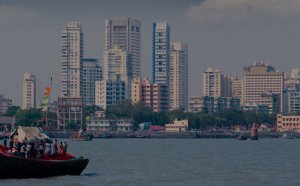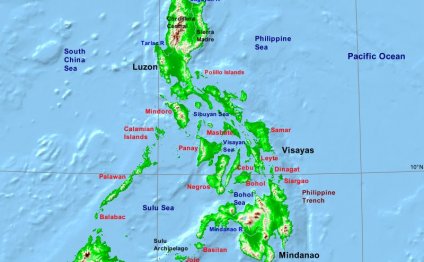
Philippines located in which country
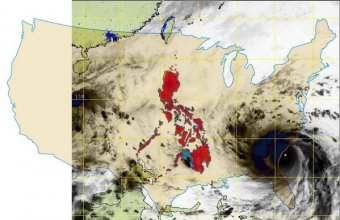 This map shows Haiyan's path westward across the Pacific. The numbers indicate the size of the storm, which peaked just as it hit the central Philippines. Manila, the country's capital and its most populous city, was out of the storm's range. But many other cities were not, including Tacloban, in Leyte province, which is indicated on the map with a yellow dot.
This map shows Haiyan's path westward across the Pacific. The numbers indicate the size of the storm, which peaked just as it hit the central Philippines. Manila, the country's capital and its most populous city, was out of the storm's range. But many other cities were not, including Tacloban, in Leyte province, which is indicated on the map with a yellow dot.
2. The size of the storm, relative to the United States
(The New Republic)
Lots of erroneous size comparisons circulated early on. The New Republic's Nate Cohn debunked those false maps, posting this accurate one. The Philippines, as you can see, marked in red, is really big (it's also highly populous, with 98 million people). And so was the typhoon that swept across it.
 3. Population density where the storm hit
3. Population density where the storm hit
(U.N. Office for the Coordination of Humanitarian Affairs)
This map zooms in on the central Philippines districts where the storm pushed through, with the regions color-coded according to population density. Produced by the United Nations' Office for the Coordination of Humanitarian Affairs, this map is crucial for understanding the storm's impact. Those darker areas have more than half a million people; see, for example, the area around Tacloban (though the city itself has a population of 218, 000) and around Cebu. This is where the humanitarian and rebuilding work is most important.
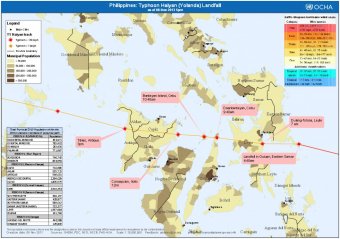 4. Affected areas
4. Affected areas
(Relief Web)
This map is from Tuesday, so the estimates for the numbers of people affected by Haiyan have almost surely since gone up. But it's important for grasping where the real damage is - those red areas have been hit very badly - as well as the fact that huge numbers of people have been affected in other parts of the country.
5. The Philippine government has a troubled track record on storm relief
Storm exposure, left, and reconstruction funds, right, by municipality in the Philippines from 2001 to 2010. (James Atkinson, Allen Hicken and Nico Ravanilla/The Monkey Cage)
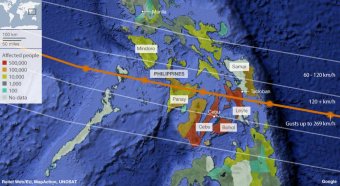 This map, via the Monkey Cage, is key to understanding why the Philippines is very likely to struggle in relief efforts - and why some hard-hit areas may have been underprepared. The Philippine government has a lot of trouble with political competition and with certain kinds of corruption. Look back up: The map on the left shows how badly each district was affected by storms between 2001 and 2010; redder districts were hit harder. The map on the right shows which districts got the most government funding for reconstruction; redder districts got more money. Theoretically, these maps should be identical. That they're not shows how the country's money-distorted political system has sometimes made it tough for it to prepare for, and respond to, storms like Haiyan.
This map, via the Monkey Cage, is key to understanding why the Philippines is very likely to struggle in relief efforts - and why some hard-hit areas may have been underprepared. The Philippine government has a lot of trouble with political competition and with certain kinds of corruption. Look back up: The map on the left shows how badly each district was affected by storms between 2001 and 2010; redder districts were hit harder. The map on the right shows which districts got the most government funding for reconstruction; redder districts got more money. Theoretically, these maps should be identical. That they're not shows how the country's money-distorted political system has sometimes made it tough for it to prepare for, and respond to, storms like Haiyan.
6. The Philippines is unusually susceptible to climate change
(Philippine Department of Environment and Natural Resources)
The Philippines is a nation of islands, with long shorelines and many low-lying areas, and it is located in a part of the world where sea levels, sea temperatures and weather patterns are expected to be disproportionately altered by the effects of climate change.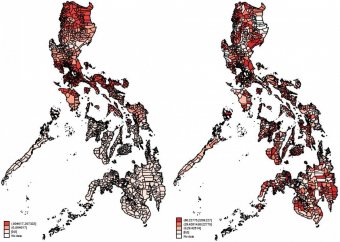 Other geographic features put the country and its 98 million people at extreme risk from climate change. A U.N. report ranked it as the third most-susceptible country in the world to climate change. This map breaks down that susceptibility, showing how 11 different regions can expect to be hammered by the different effects of our changing climate. Haiyan may not be directly attributable to climate change, but it demonstrates what makes the country so vulnerable to rising seas and accelerating winds.
Other geographic features put the country and its 98 million people at extreme risk from climate change. A U.N. report ranked it as the third most-susceptible country in the world to climate change. This map breaks down that susceptibility, showing how 11 different regions can expect to be hammered by the different effects of our changing climate. Haiyan may not be directly attributable to climate change, but it demonstrates what makes the country so vulnerable to rising seas and accelerating winds.
7. Aid and recovery efforts
A Google crisis-response team is working with groups in the Philippines to run this constantly updated map of relief efforts. It shows evacuation centers, health facilities, police offices, transportation options and relief drop-off centers. The idea is to make it easier for organizations and individuals to share information. The Google team also set up a person finder to help assist in finding displaced or missing people.
8. The damage in Tacloban: before and after satellite photos
These images, collected by Google Earth and assembled by The Washington Post's graphics team, show the devastated city of Tacloban before and after the storm hit. No map could truly convey the human cost of the storm, of course, but these images at least hint at its extent.
RELATED VIDEO
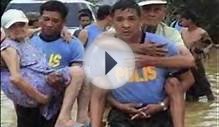


Share this Post
Related posts
Forum Philippines
Welcome to the SWIFT Business Forum Philippines 2016 2016 marks a significant milestone for the financial services community…
Read MoreBrothels in Philippines
Dondi Tawatao | Getty Images Once opposed to the prospect of a major naval base inside this picturesque Philippine cove…
Read More
